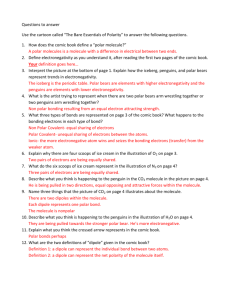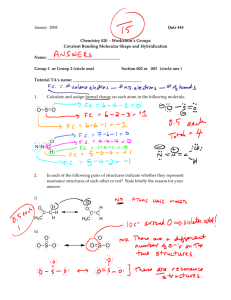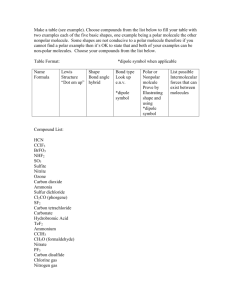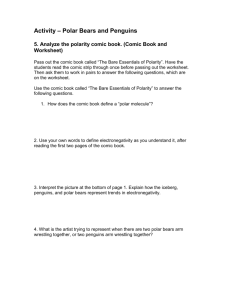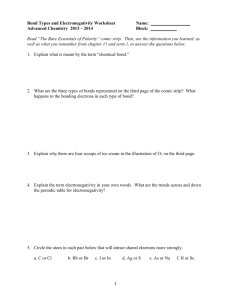Smells TG pp247
advertisement
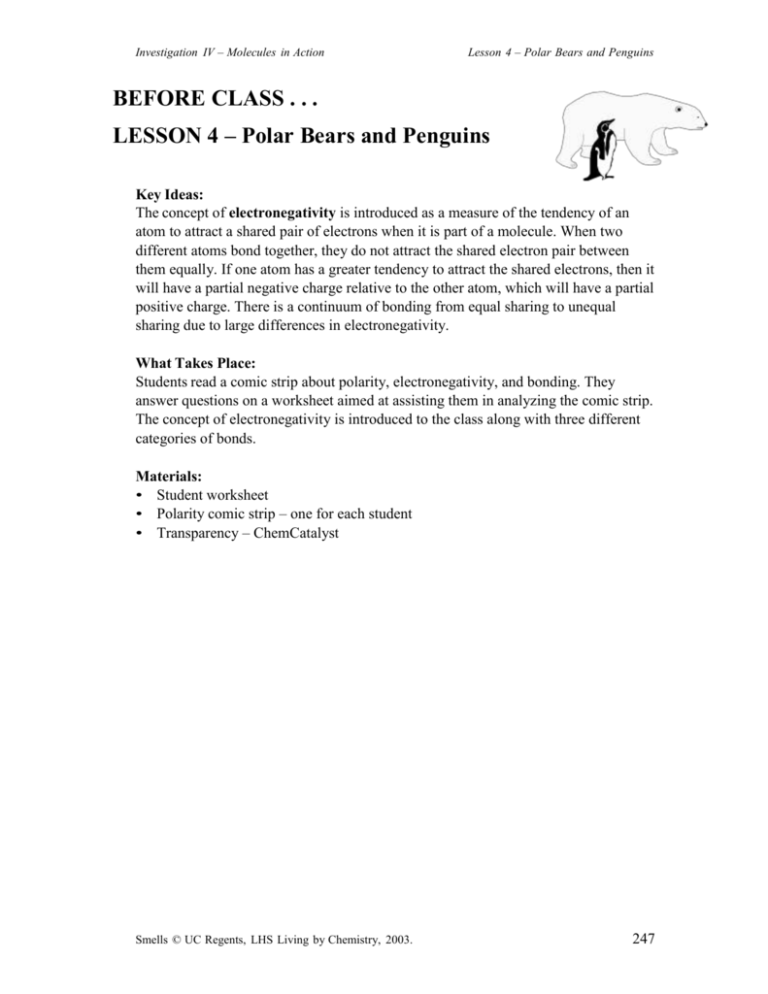
Investigation IV – Molecules in Action Lesson 4 – Polar Bears and Penguins BEFORE CLASS . . . LESSON 4 – Polar Bears and Penguins Key Ideas: The concept of electronegativity is introduced as a measure of the tendency of an atom to attract a shared pair of electrons when it is part of a molecule. When two different atoms bond together, they do not attract the shared electron pair between them equally. If one atom has a greater tendency to attract the shared electrons, then it will have a partial negative charge relative to the other atom, which will have a partial positive charge. There is a continuum of bonding from equal sharing to unequal sharing due to large differences in electronegativity. What Takes Place: Students read a comic strip about polarity, electronegativity, and bonding. They answer questions on a worksheet aimed at assisting them in analyzing the comic strip. The concept of electronegativity is introduced to the class along with three different categories of bonds. Materials: • Student worksheet • Polarity comic strip – one for each student • Transparency – ChemCatalyst Smells © UC Regents, LHS Living by Chemistry, 2003. 247 Investigation IV – Molecules in Action Lesson 4 – Polar Bears and Penguins Investigation IV – Molecules in Action LESSON 4 – Polar Bears and Penguins Students explore polarity further by interpreting the scenes from a comic book on the topic in which penguins and polar pairs are bonded to one another through an ice cream cone with scoops of ice cream. The polar bears win out over the penguins in attracting the scoops to their mouths. This is an analogy for electron pairs in bonds, which tend to be attracted towards one of the atoms sharing the electrons. Electronegativity is introduced as a measure of this tendency and as an explanation for partial charges on atoms in molecules, which give rise to polarity. Exploring the Topic (10 min) 1. Introduce the ChemCatalyst exercise. (Transparency) Display the following ChemCatalyst question for students to complete individually. Consider the following illustration: • Draw the Lewis dot structure for HCl. • If the penguin represents a hydrogen atom and the polar bear represents a chlorine atom, what does the ice cream represent in the drawing? What do you think the picture is trying to illustrate? • Would HCl be attracted to the charge wand? Explain your thinking. 2. Discuss the ChemCatalyst exercise. Use the discussion to get a sense of the students’ initial ideas. Smells © UC Regents, LHS Living by Chemistry, 2003. 248 Investigation IV – Molecules in Action Lesson 4 – Polar Bears and Penguins Discussion goals: Begin to discuss unequal sharing of electrons. Sample questions: What do you think the drawing is trying to illustrate? Why is the larger animal representing the chlorine atom? Why is the penguin being swept off his feet by the polar bear? Do you think HCl will be attracted to a charged wand? Students should have a wide range of individualized responses to these questions. We hope they will deduce that the ice cream scoops represent bonded electrons. The polar bear appears to be pulling on the bonded electrons more strongly than the penguin. The polar bear is a bigger animal representing a bigger atom. The chlorine atom pulls on the bonded pair of electrons harder than the hydrogen atom. This means that the electrons are not shared evenly. Some students may begin to speculate that this would cause a partial charge and that HCl would therefore be attracted to a charged wand. Simply accept/acknowledge all ideas at this point. 3. Refine definition of polarity. Provide students with a simple explanation of the ChemCatalyst cartoon as a bridge to the activity. Keep the ChemCatalyst transparency on the board for this discussion. Discussion goals: Begin to discuss how partial charges are created. Use the discussion as a springboard into the comic book activity. Sample questions: What did the charged wand demonstrate in the last activity? (the presence of a charge on the molecules of certain liquids) In what ways do polar molecules differ from nonpolar molecules? (intermolecular interactions, boiling point, etc.) What explanation for partial charges does the ChemCatalyst illustration provide? (see paragraph below) Points to cover: In the last lesson it was demonstrated that certain liquids are attracted to a charged wand because of partial charges on the molecules. However, we did not have any explanation for the existence of these partial charges. The polar bear-penguin cartoon provides a symbolic explanation for polarity. The chlorine atom, represented by the polar bear, attracts the pair of bonded electrons that are shared between the hydrogen atom and the chlorine atom more strongly. In fact, the chlorine atom attracts these shared electrons so strongly that they are more often found around the chlorine atom than the hydrogen atom. This results in a partial negative charge on the chlorine atom and a partial positive charge on the hydrogen atom. Today’s activity will explore this tendency to attract a shared pair of electrons in more detail. Smells © UC Regents, LHS Living by Chemistry, 2003. 249 Investigation IV – Molecules in Action Lesson 4 – Polar Bears and Penguins 4. Explain the purpose of the activity If you wish you can write the main question on the board. Points to cover: Tell students they will be reading a comic book on the subject of polarity. They will be gathering information that will assist them in answering the question: “How can we explain partial charges on molecules?” Activity – Polar Bears and Penguins (15 min) 5. Analyze the polarity comic book. (Comic Book and Worksheet) Pass out the comic book called “The Bare Essentials of Polarity”. Have the students read the comic strip through once before passing out the worksheet. Then ask them to work in pairs to answer the following questions, which are on the worksheet. Use the comic book called “The Bare Essentials of Polarity” to answer the following questions. 1. How does the comic book define a “polar molecule”? 2. Use your own words to define electronegativity as you understand it, after reading the first two pages of the comic book. 3. Interpret the picture at the bottom of page 1. Explain how the iceberg, penguins, and polar bears represent trends in electronegativity. 4. What is the artist trying to represent when there are two polar bears arm wrestling together, or two penguins arm wrestling together? 5. What three types of bonds are represented on the third page of the comic book? What happens to the bonding electrons in each type of bond? 6. Explain why there are four scoops of ice cream in the illustration of O2 on page 3. (There are four electrons being shared. Oxygen has a double bond.) 7. What do the six scoops of ice cream represent in the illustration of N2 on page 4? (Three bonded pairs of electrons represent a triple bond.) 8. Describe what you think is happening to the penguin in the CO2 molecule in the illustration on page 4. 9. Name three things that the picture of CO2 on page 4 illustrates about the molecule. 10. Describe what you think is happening to the penguins in the H2O molecule in the illustration on page 4. 11. Explain what you think the crossed arrow represents in the comic book. 12. What are the two definitions of “dipole” given in the comic book? Making Sense What does electronegativity have to do with polarity? Smells © UC Regents, LHS Living by Chemistry, 2003. 250 Investigation IV – Molecules in Action Lesson 4 – Polar Bears and Penguins If you finish early Using polar bears and penguins, create an illustration showing a hydrogen sulfide molecule, H2S. (Hint: You may wish to start with a Lewis dot structure.) Making Sense Discussion (15 min) Major Goals: The processing of the comic book should focus on the main idea that electrons are not shared equally unless they are shared between identical atoms. Electronegativity should be defined and related to polar covalent, nonpolar covalent, and ionic bonds. Finally, examine how shape plays a role in determining the polarity of the entire molecule. 6. Define electronegativity. When you get to the appropriate part of the discussion draw a picture of HCl on the board. Add the direction of the dipole and partial charges as you explain how the electrons are shared unequally. Discussion goal: Assist students in sharing their new understanding of polarity and how it relates to electronegativity. Sample questions: List some of the things you learned about polarity from the comic book. How would you use polar bears and penguins to illustrate a polar molecule? A nonpolar molecule? According to the comic book, which elements tend to attract shared electrons to the greatest degree? Points to cover: When two atoms with different electronegativities are bonded, they tend to attract the bonded electrons to different degrees. This causes the electrons to spend more time around one of the atoms, resulting in a partial negative charge on this atom. This tendency of an atom to attract electrons shared between two atoms is called electronegativity. An atom that strongly attracts the shared electrons is considered highly electronegative. The atom with lower electronegativity will end up with a partial positive charge on it. The result is a polar bond. Chemists have a specific name for a molecule that has two poles — it is called a dipole. ("Di" means two.) Using hydrogen chloride as an example, we can illustrate how the highly electronegative chlorine atom attracts the shared electrons to a greater degree, resulting in partial charges on the molecule. Smells © UC Regents, LHS Living by Chemistry, 2003. 251 Investigation IV – Molecules in Action Lesson 4 – Polar Bears and Penguins This illustration also uses a crossed arrow to show the direction of the dipole in HCl. The crossed end of the arrow indicates the positive (+) end of the polar bond and the arrow points in the direction of the negative (-) end. Electronegativity values generally increase moving from left to right across the periodic table, thus the iceberg at the bottom of page 1 not only increases in thickness, but also has increasingly larger animals, including larger polar bears. Polar molecules are also called dipoles. The prefix di- means two. A dipole is a molecule with two partially charged ends, or poles. Chemists refer to polar molecules as dipoles and they also say that molecules with polar bonds have dipoles. This nomenclature can be a bit confusing with two related meanings for two closely-related meanings for the same word. wwwsameword. 7. Relate electronegativity to bonding. Provide students with a general description of the three categories of bonds encountered in the comic book. Discussion goal: Assist students in differentiating between bonds that are nonpolar covalent, polar covalent, and ionic, depending on differences in electronegativity. Sample questions: How does the comic book illustrate the range of possible ways of sharing electrons? What kind of charges form on the ions of elements that are the most electronegative? (they tend to form negative ions) What about the least electronegative elements? (they tend to form positive ions) Why does the polar bear tell the penguin to try to be more positive? (the polar bear benefits more when the penguin is “more positive” – the more the polar bear attracts the shared pair of electrons, the more positive the partial charge on the penguin) Smells © UC Regents, LHS Living by Chemistry, 2003. 252 Investigation IV – Molecules in Action Lesson 4 – Polar Bears and Penguins Points to cover: In a molecule such as H2, the atoms are identical, so there is no difference in the degree to which each atom in the molecule attracts the shared electrons. These molecules are covalent and nonpolar. Nonpolar covalent bonds are the only bonds in which the electrons are truly shared equally. If the electronegativities between two atoms are even slightly different they form what is called a polar covalent bond. When the electronegativities between two atoms are greatly different the bond is called an ionic bond. In the case of an ionic bond the electron of one atom is completely given up to the other atom. The result of this kind of bond is two separate ions – one with a negative charge and the other with a positive charge. NaCl, sodium chloride (table salt), is an example of a compound with an ionic bond. Remember, just because an electron is completely transferred from one atom to another, does not mean that the bond between the two atoms is a weak one. Ionic bonds are quite strong. 8. Discuss how shape may relate to polarity. Refer students to the illustrations of CO2 on page 4 of the comic book. Explain how the shape of carbon dioxide results in a neutral, nonpolar molecule, even though the C=O bond is polar. Discussion goal: Assist students in interpreting the illustration of carbon dioxide in the comic book. Sample questions: What is happening to the penguin in the illustration of carbon dioxide on page 4 of the comic book? What things does this illustration tell us about carbon dioxide? (There are double bonds between the C and each O; carbon is less electronegative than oxygen; the overall molecule is not polar.) Although the electrons are not shared equally between C and O, CO2 is a nonpolar molecule. Explain why. Why is H2O a polar molecule? Points to cover: The illustration of CO2 shows a penguin being pulled between two large polar bears. The penguin represents a carbon atom in this drawing, and the polar bears are two oxygen atoms. The penguin is being pulled with equal strength or force in both directions. The fact that the penguin is being pulled means that the C=O bonds are polar. Nevertheless, they are pulling in equal and opposite directions. The net result is a neutral molecule. Thus, carbon dioxide is nonpolar even though it has two polar bonds. We will find more evidence later on that symmetrical molecules are often nonpolar due to their overall shape and conformation. Smells © UC Regents, LHS Living by Chemistry, 2003. 253 Investigation IV – Molecules in Action Lesson 4 – Polar Bears and Penguins O C O Students may notice that carbon and oxygen are next to each other on the periodic table and conceivably have electronegativities that are similar. According to the illustration at the bottom of page 1 of the comic book, both carbon and oxygen should be represented by polar bears. The carbon bear would be smaller and not as strong as the two oxygen bears. Apparently the artist used a penguin instead of a polar bear in order to make the point very clear that carbon has less attraction for bonded electrons than oxygen. Check-in (10 min) 9. Introduce the Check-in exercise. Write the following exercise on the board for students to complete individually. Draw a picture of HI on the board as two circles linked together by a line. Label each atom (H and I). Students may wish to refer to the periodic table. • • Is the bond between these atoms polar? Explain your reasoning. How would the atoms be portrayed in the comic book – as polar bears, penguins, or both? Explain. 10. Discuss the Check-in exercise. Get a sense of the level of understanding by collecting students’ work or asking students to defend their choices. Discussion goals: Make sure that students have a grasp of polarity and electronegativity as they relate to the comic book. Sample questions: Is this molecule polar? Explain. (Yes, the electrons are not shared evenly.) Which atom(s) would be polar bears or penguins? (Hydrogen would be a penguin and iodine would be a polar bear.) Which atom is more electronegative? Explain why you think so. (Iodine, because it is represented by a larger, stronger animal, the polar bear.) Smells © UC Regents, LHS Living by Chemistry, 2003. 254 Investigation IV – Molecules in Action Lesson 4 – Polar Bears and Penguins On which end of a hydrogen iodide molecule would you find a partial negative charge? (iodine end) In which direction are the electrons attracted? (towards iodine) 11. Wrap-up Assist the students in summarizing what was learned in this class. • Anytime there are two different types of atoms sharing electrons, there will be a partial negative charge on one atom and a partial positive charge on the other atom. • Electronegativity measures the tendency of an atom to attract the electrons in a bond. • The bonds are labeled nonpolar covalent, polar covalent, and ionic as the difference in electronegativity between the two atoms in the bond increases. Homework 12. Assign homework. Use the homework provided with the curriculum or assign your own. Assign “The Bare Essentials of Polarity” (comic pages) for reading. Smells © UC Regents, LHS Living by Chemistry, 2003. 255 Investigation IV – Molecules in Action Lesson 4 – Polar Bears and Penguins Homework – Investigation IV – Lesson 4 1. Read the comic “The Bare Essentials of Polarity.” In your own words, explain the 3–5 main ideas. What do the polar bears represent? What do the penguins represent? 2. Using polar bears and penguins, create an illustration showing an ammonia molecule, NH3. (Hint: You may wish to start with a Lewis dot structure.) Smells © UC Regents, LHS Living by Chemistry, 2003. 256 Investigation IV – Molecules in Action Lesson 4 – Polar Bears and Penguins ChemCatalyst • Draw the Lewis dot structure for HCl. • If the penguin represents a hydrogen atom and the polar bear represents a chlorine atom, what does the ice cream represent in the drawing? What do you think the picture is trying to illustrate? • Do you think HCl will be attracted to a charged wand? Explain your thinking. Smells © UC Regents, LHS Living by Chemistry, 2003. 257 Investigation IV – Molecules in Action Lesson 4 – Polar Bears and Penguins “Dipole Vector” pointing You don’t have to go to the ends of the earth to find POLAR MOLECULES. towards negative charge They’re all over the place. A polar molecule is just a molecule with a difference in electrical charge between two ends. Partial Partial positive negative charge charge The electrical imbalance of POLARITY is caused by the difference in ELECTRONEGATIVITY between atoms. Electronegativity is the ability of an atom/nucleus to attract bonding electrons towards itself. Bonded pair of electrons HEY! In HCl, the bonded pair of electrons spends more time near the chlorine’s nucleus because chlorine is more electronegative than hydrogen. The periodic table shows a general trend in the electronegativity of the elements. Electronegativity tends to rise as you move “northeast” on the periodic table, and fall as you move “southwest”. Note: the noble gases, in the periodic table’s far right column, are often assigned an electronegativity value of zero because they are relatively unreactive. Smells © UC Regents, LHS Living by Chemistry, 2003. 258 Investigation IV – Molecules in Action Lesson 4 – Polar Bears and Penguins When two atoms with unequal electronegativity values bond, they do not share the bonding electrons evenly. The bonding electrons spend more time around the more electronegative atom, creating a PARTIAL NEGATIVE CHARGE on that atom. The other atom then has a PARTIAL POSITIVE CHARGE, and the bond polar. OH, TRY TO BE MORE POSITIVE. POLARIY IS SO UNFAIR! So the polarity of a bond is a function of the difference between the electronegativity values of two bonding atoms. Bonded atoms with equal electron-attracting strength will have nonpolar bonds. However, if the electronegativity of the two bonded atoms is unequal, then their bond will be polarized—maybe a little. …maybe a lot. Smells © UC Regents, LHS Living by Chemistry, 2003. 259 Investigation IV – Molecules in Action Lesson 4 – Polar Bears and Penguins Because the elements have such varying electronegativities and can come together in so many different combinations, there is really a CONTINUUM OF POLARITY IN BONDING. For convenience, we can break the continuum down into three categories: (1) nonpolar covalent, (2) polar covalent,and (3) ionic. NONPOLAR COVALENT (O2 is double bonded.) The clearest examples of nonpolar covalent bonds are those between identical atoms, such as H2, O2, or Cl2. Bonds between atoms with nearly the same electronegativity value, such as carbon and hydrogen atoms, are usually considered nonpolar. Remember, this is really a continuum, and conventional distinctions are somewhat artificial. POLAR COVALENT Partial negative charge Partial positive charge In a polar covalent bond, two atoms still share bonded pairs of electrons, but those electrons are decidedly more attracted to one atom than the other. Examples include bonds between carbon and oxygen atoms, or between hydrogen and fluorine atoms. IONIC Negative charge Positive charge At the extreme of difference in the electronegativity, polar covalence shades into a winner-take-all situation of ionic bonding. The more electronegative atom seizes the bonding electron and becomes a negative ion. The opposite charges on the ions attract each other. Smells © UC Regents, LHS Living by Chemistry, 2003. 260 Investigation IV – Molecules in Action Lesson 4 – Polar Bears and Penguins Polar bonds between atoms constitute DIPOLES. Actually, the word ”dipole” can refer to several different things that are relevant here: (1) the polarity of an individual polar bond between atoms, (2) the net polarity of a polar molecule that may have several polar covalent bonds within it, and (3) the polar molecule itself. Confusing! Let’s look at some examples. An N2 molecule isn’t a dipole (it’s not a polar HCl has a dipole (a polar bone) and it is a dipole (a molecule), and it doesn’t have any dipoles (polar polar molecule). bonds) within it. BOND: MOLECULE: BOND: NONPOLAR MOLECULE: NONPOLAR On the other hand, CO2 has two dipoles (two polar bonds), but the CO2 molecule itself is not a dipole because its polar bonds cancel each other out and make the molecule nonpolar. overall. Like CO2, H2O has two dipoles (wo polar bonds). But because of H2O’s bent shape (caused by lone pairs of electrons on the oxygen atom), H2O also has a dipole in the sense of an overall polarity. So H2O is a dipole in the sense of being a polar molecule. BONDS: MOLECULE: NONPOLAR BONDS: MOLECULE: The polarity of molecules can affect many of their other properties, such as their solubility, their boiling and melting points, and their odor. WHY ARE WE IN THIS COMIC STRIP? PENGUINS AND POLAR BEARS DON’T EVEN LIVE AT THE SAME POLES! SUITS ME! MMMMM, YOU SMELL PENGUINY. Smells © UC Regents, LHS Living by Chemistry, 2003. 261 Investigation IV – Molecules in Action Polar Bears and Penguins Lesson 4 – Polar Bears and Penguins Name: Period: Date: Purpose: In this lesson you will be exploring polarity and bonding between atoms in greater detail. A comic book will provide new information about these topics and will introduce you to the concept of electronegativity, which helps us to understand partial charges. Use the comic book called “The Bare Essentials of Polarity” to answer the following questions. 1. How does the comic book define a “polar molecule?” 2. Define electronegativity as you understand it, after reading the first two pages of the comic book. 3. Interpret the picture at the bottom of page 1. Explain how the iceberg, penguins, and polar bears represent trends in electronegativity. 4. What is the artist trying to represent when there are two polar bears arm wrestling together, or two penguins arm wrestling together? 5. What three types of bonds are represented on page 3 of the comic book? What happens to the bonding electrons in each type of bond? Smells © UC Regents, LHS Living by Chemistry, 2003. 262 Investigation IV – Molecules in Action Lesson 4 – Polar Bears and Penguins 6. Explain why there are four scoops of ice cream in the illustration of O2 on page 3. 7. What do the six scoops of ice cream represent in the illustration of N2 on page 4? 8. Describe what you think is happening to the penguin in the CO2 molecule in the picture on page 4. 9. Name three things that the picture of CO2 on page 4 illustrates about the molecule. 10. Describe what you think is happening to the penguins in the illustration of H2O on page 4. 11. Explain what you think the crossed arrow represents in the comic book. 12. What are the two definitions of “dipole” given in the comic book? Making Sense What does electronegativity have to do with polarity? If you finish early. . . Using polar bears and penguins, create an illustration showing a hydrogen sulfide molecule, H2S. (Hint: You may wish to start with a Lewis dot structure.) Smells © UC Regents, LHS Living by Chemistry, 2003. 263
